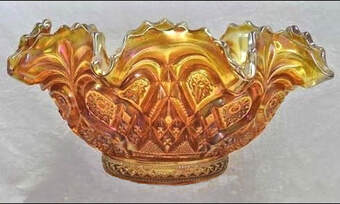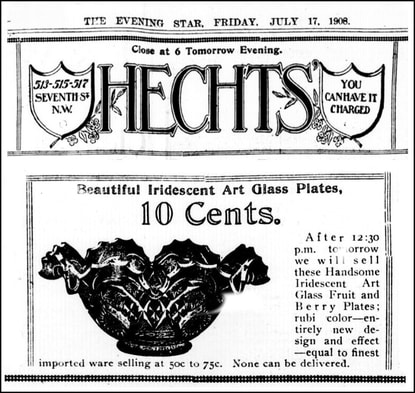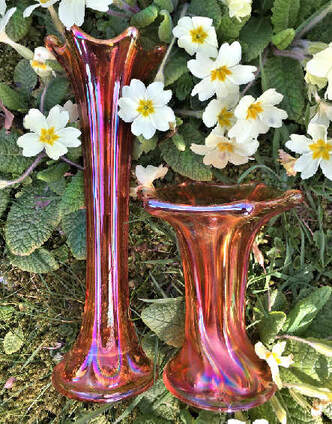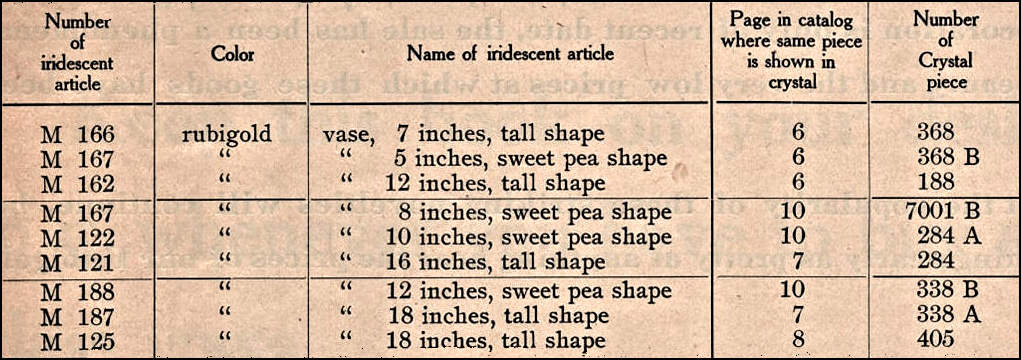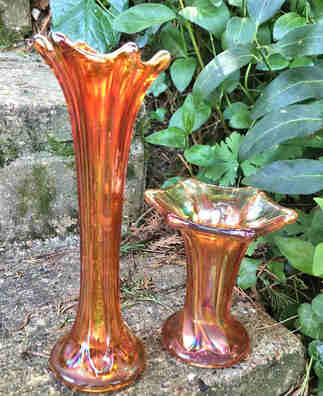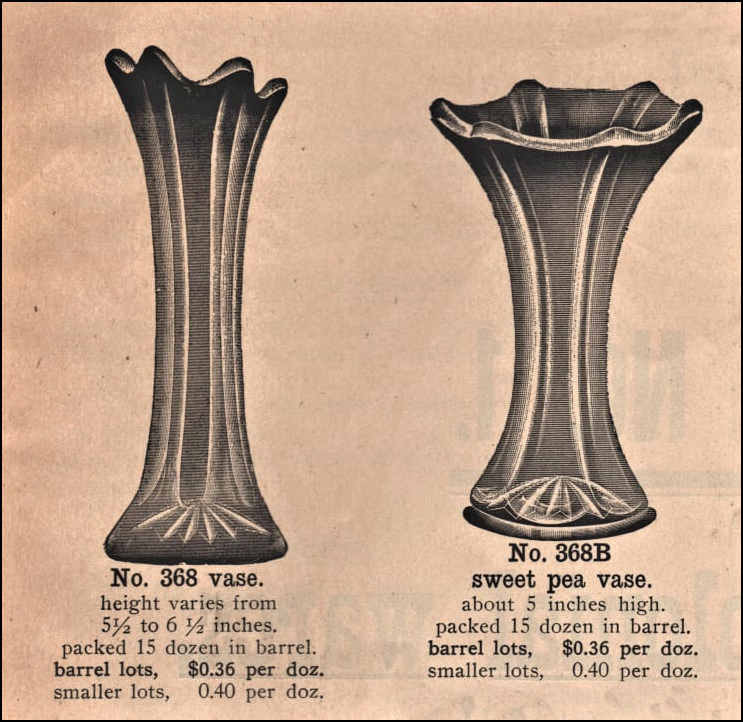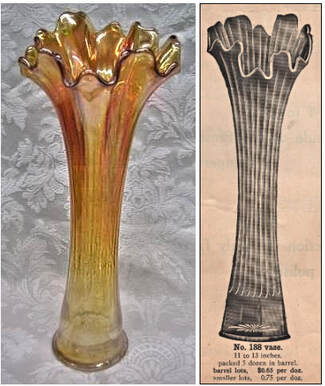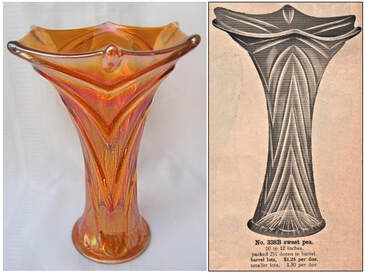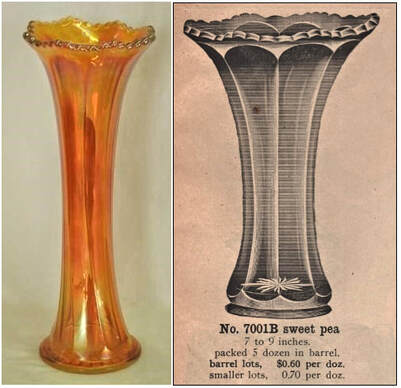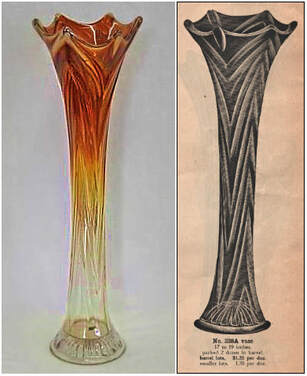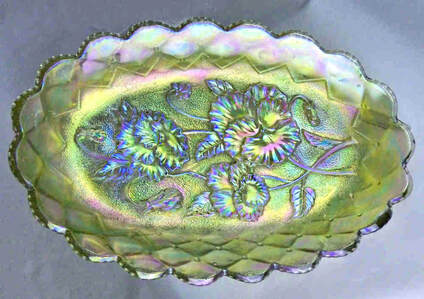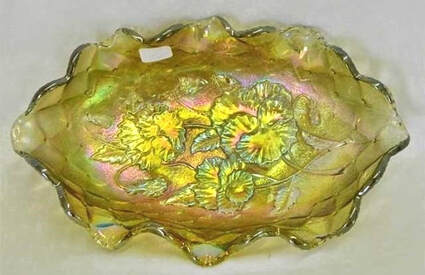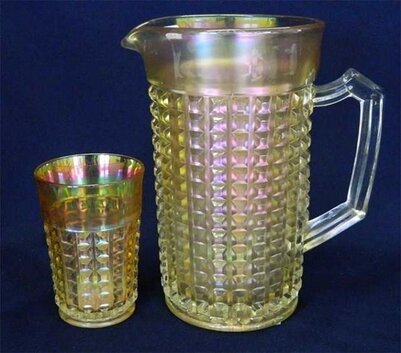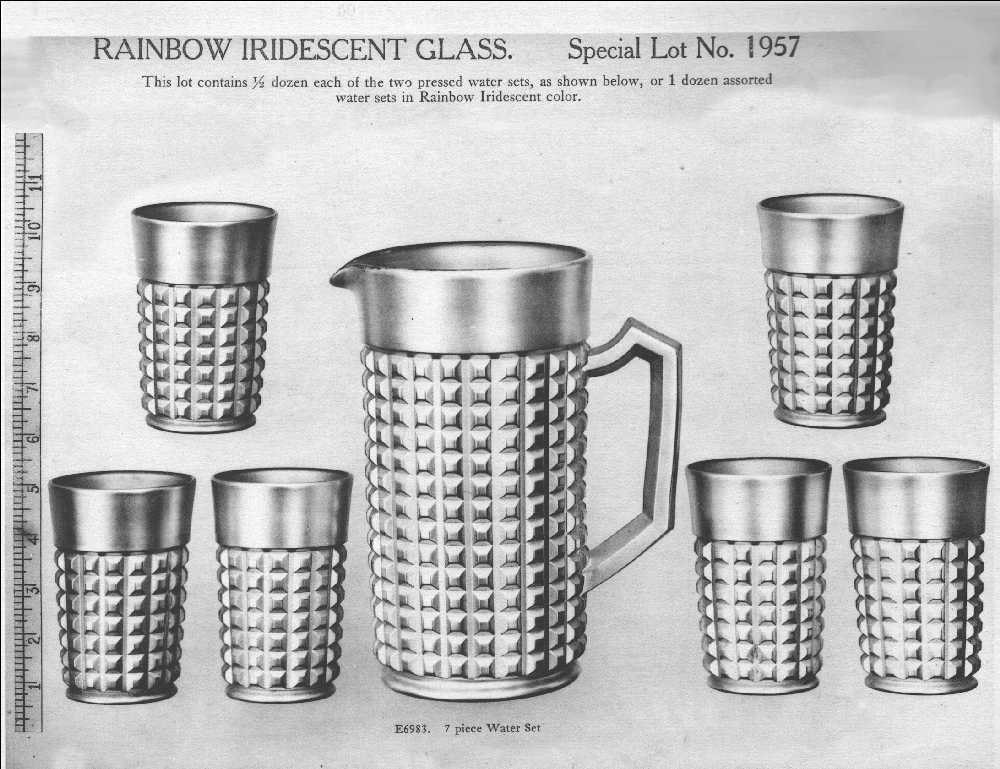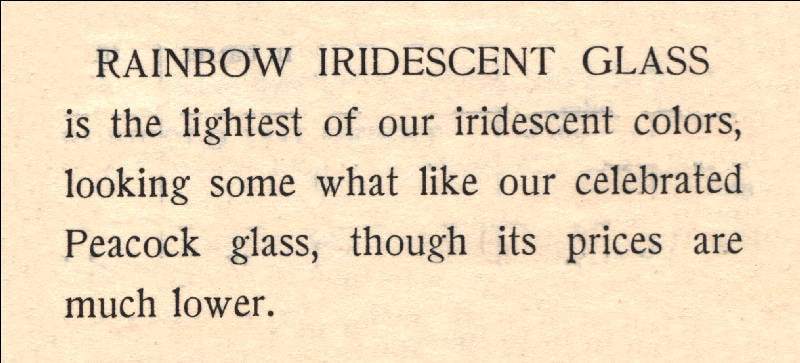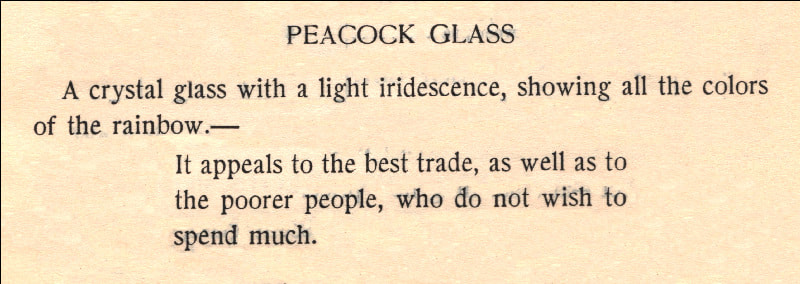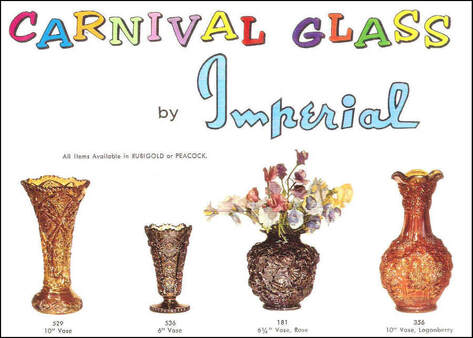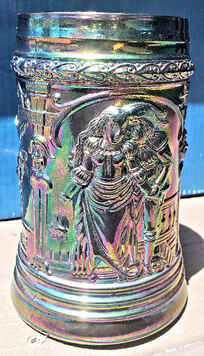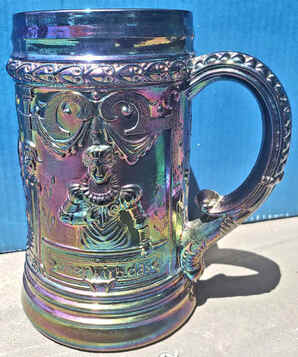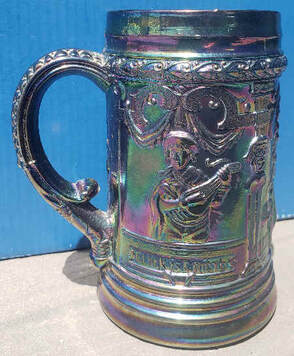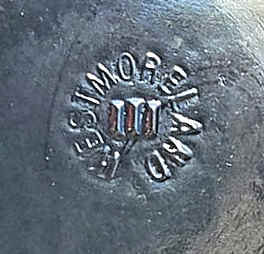NetworK ezine Issue 72. May 2021
Totally Devoted to Carnival Glass
A warm welcome to the May issue of our Carnival Glass NetworK ezine which focuses on Imperial. Spring is showing its full glory here in the northern hemisphere, epitomized in the charm of the primroses featured in the photo above – a perfect setting for two little, marigold Morning Glory vases by Imperial. The taller vase on the left is only 8” high, while the tiny one with the widely flared mouth stands a fraction over 4”. The base diameter of both is 2.5”.
Imperial’s First Carnival Glass
It’s widely believed that Fenton were first to produce Carnival – but they were not alone at the starting block. Westmoreland advertised their iridescent items in a Fall 1908 Butler Brothers catalogue, and in September 1908, Butler Brothers carried an ad for Fenton’s “Golden Sunset Iridescent Assortment”. But it’s seldom realised that Imperial’s Iridescent glass was actually advertised in the Washington Evening Star as early as July 17th 1908.
Imperial’s First Carnival Glass
It’s widely believed that Fenton were first to produce Carnival – but they were not alone at the starting block. Westmoreland advertised their iridescent items in a Fall 1908 Butler Brothers catalogue, and in September 1908, Butler Brothers carried an ad for Fenton’s “Golden Sunset Iridescent Assortment”. But it’s seldom realised that Imperial’s Iridescent glass was actually advertised in the Washington Evening Star as early as July 17th 1908.
|
The Carnival Glass on offer in that ad was Imperial’s No. 400, better known to collectors as “Royalty”, pictured below, courtesy of Seeck Auctions. Here is the 1908 ad.
|
Imperial’s Morning Glory vases
on a bed of woodland primroses The shape shown in the ad was what we know as the punch bowl top or fruit bowl – yet oddly, it was presented as an “Iridescent Art Glass Plate” in the ad. (We explore this in a major feature on our website – the link is at the end of this article). Imperial’s January 1909 catalog made no reference to their iridescent products, but their October 1909 catalog had two pages of plain text (no illustrations) that referred to their Rubigold Iridescent Ware. Then, in 1910, Imperial devoted a full section of their catalog to the promotion of their Rubigold Iridescent lines, describing their iridescent ware as “vastly superior to anything seen by us, so far”. |
A Review of Carnival Glass in Imperial’s 1910 Catalog
In a section entitled “Rubigold iridescent ware”, Imperial explained why they had not shown illustrations of their iridescent glass – put simply, they felt it would not do justice to the beauty of the items. They wrote: “… it has been impossible so far, to give by illustrations even a faint idea of the peculiar color effects of this most modern glass, which change with every change of the light and with every change of position. All the colors of the rainbow unite in creating these effects, and we have discovered just now additional color combinations which are vastly superior to anything seen by us, so far”.
|
It’s fascinating to read that description, written over a century ago, and realise it is exactly how so many of us try to describe our Carnival today. On the following pages of the catalog, Imperial listed what they described as their “most important iridescent pieces” in Rubigold (marigold) – an eye-opening list in itself, as it allows us to discover exactly which items were their most popular in 1910. And can you guess what shape and pattern might have been at the very top of the list of Imperial’s “most important Rubigold wares”? The clue’s above in our top photo. Yes, it was the Morning Glory vases, in a variety of shape and size. |
Imperial 1910 catalog. Courtesy Jon D Bartell / Glass Paper Fanatics.
|
Some ninety items in Rubigold (marigold) were noted in the “most important” list. Shown above are the top nine, which are all swung* vases. They were all described as “high grade … every piece is highly finished and fire polished”. In the column on the left, items were listed with three-digit numbers prefixed with the letter M (which denoted the colour Rubigold). None were illustrated in this special section, and instead, cross references were given so that the customer could search in the catalogue for the page where the item was shown in crystal with a totally different pattern reference number! It’s a nightmare to follow and we can only imagine the difficulties the customers might have had trying to match them all up. (To make it even more confusing for collectors today, Imperial gave different pattern numbers to some pieces that today have the same “collector” pattern name.
|
Making it even more confusing for collectors, Imperial gave different pattern numbers to some pieces that today have the same “collector” pattern name. Morning Glory, for example, had four different Imperial pattern numbers - 368, 284, 405 and 198 - that varied with size and number of ribs. The first two items in Imperial's list were Morning Glory vases, M 166 (Imperial pattern number 368) and M 167 (Imperial pattern number 368 B). In the list they are described as 7” tall and 5” tall, respectively. The examples in our photo (right) are slightly different, being 8” and around 4” – but they give a good representation, and the 1910 Imperial image of the crystal vases would have helped the customer. |
Imperial 1910 catalog.
Courtesy Jon D Bartell / Glass Paper Fanatics. |
So, what about the remainder of that top nine? All were vases; the others were the 12” Freefold vase (M 162), Imperial’s 8” Flute vase (M 167), and two Gothic Arches vases (M 188 the 12” size and M 187 the 18” size).
|
Above: Freefold vase, courtesy Burns Auctions.
Freefold vase M 162, No. 188, Imperial 1910 catalog, courtesy Jon D Bartell / Glass Paper Fanatics. Above: Gothic Arches vase, courtesy Burns Auctions.
Gothic Arches vase M188, No 338 B, Imperial 1910 catalog, courtesy Jon D Bartell / Glass Paper Fanatics. Thanks to the Glass Paper Fanatics, the Imperial 1910 catalog will be placed in the Imperial Museum at Bellaire. * Note that all the vases were described by Imperial according to their heights, whereas today’s collectors like to classify swung vases according to their base diameters. |
Above: Flute vase, 8” tall, courtesy Seeck Auctions.
Flute vase M 167, No. 7001B, Imperial 1910 catalog, courtesy Jon D Bartell / Glass Paper Fanatics. Above: Gothic Arches vase, 18” tall, courtesy Seeck Auctions.
Gothic Arches vase M 187, No 338 A, Imperial 1910 catalog, courtesy Jon D Bartell / Glass Paper Fanatics. |
This is the process that was used to make Swung Vases: vase moulds are relatively stubby in height (generally around four to six or seven inches). When the vase was taken out of the mould, the base was held in a tool called a snap, and the vase was reheated in the glory hole, so that the glass becomes elastic and malleable. Whilst still hot, the glassmaker would then swing the vase, stretching it out to its intended finished height which would vary, depending on various factors (not only the actual height intended), such as the temperature and elasticity of the glass, and the swinging effort applied by the glassmaker.
In the next issue of NetworK we'll take a look at more revealing information found in this Imperial catalog.
Read more here:
Imperial made Classic Carnival from 1908 - the Proof
Imperial's Royalty pattern and its Patent
|
Imperial’s Clambroth: Peacock and Rainbow Glass
Clambroth is a colour description used by Carnival collectors. Some collectors see it as a ginger ale colour, but that seems to be inadequate for its soft and subtle, yellow iridescent effect, shot with pink, lime, blue and aqua, as shown by this Imperial Pansy relish in clambroth (right) The colour was introduced by Imperial around 1922, but they didn't call it clambroth - they referred to it as their “famous Peacock glass” claiming it to be “the biggest selling line of glassware in existence today”. So, what exactly is it – and how do we actually know when Imperial first started using it? It is a difficult colour to describe, so let’s start with how Imperial themselves told their customers about it in their Second Bargain Book (believed to be from c. 1924), and in their catalogue. No. 200 (from c. 1925). Their description of the colour “Peacock" was "This glass has a very brilliant iridescence, but the effect is not loud. Every color of the rainbow is represented, a golden yellow being the feature. Many color variations.” Note the reference Imperial made to “golden yellow” – that is probably the key feature of Imperial’s clambroth. But other colours shimmer into the mix – a fact that Imperial noted elsewhere in their Catalog 200, when they described it as also having a “golden pinkish effect”. Turquoise and aqua shades often intermingle too, the entire effect being what Imperial described as “dainty” and “not loud”. A reference to the date of the introduction of Imperial’s “Peacock” colour is provided by the appearance of a report in the 1922 “Crockery and Glass Journal” describing their “Peacock line” as “a new and exceedingly rich effect.” This date is echoed in Imperial’s Catalog 200 (c. 1925) where “Peacock” was referred to as their “22 Color”. And then, just to add another term into the mix, Imperial also described their “latest addition” to their iridescent lines in their Second Bargain Book (c. 1924) as “Rainbow Iridescent Glass”, described as having a colour “very similar to the Peacock, though of a somewhat lighter tint”. So, Peacock and Rainbow were the names for the slightly differing shades of what we call clambroth today. |
Two intentional shades of Imperial's clambroth.
Above is a Pansy relish dish, and below (courtesy Seeck Auctions) is a Pansy pickle dish |
Below are extracts from the Price List for the Imperial Second Bargain Book (c. 1924), both courtesy of Jon D Bartell. They add so much more to the bigger picture, giving us vital, new information. Note that “Peacock” is described as being “crystal glass” – that is clear base glass – with iridescence. This gives us the definition of what we know as clambroth, according to the actual manufacturer! It was on clear base glass.
|
The “Rainbow Iridescent Glass” description doesn’t mention crystal – and was a lower priced line, that was intended to look “some what like” the more expensive “Peacock”. Possibly it was made using Imperial’s lower price, lower quality “utility glass” that was not so clear and pure as their crystal. Some collectors maintain that clambroth has a ginger ale coloured base glass – but according to Imperial, that wasn’t the case. It’s entirely possible, of course, that some examples were made using glass that had not been totally decolorised – cheaper quality glass maybe – and these pieces appear to have a yellowish base glass. But the finer quality items – the more expensive “Peacock”, which “appeals to the best trade” – were undoubtedly made with a clear, crystal base glass. IMPORTANT NOTE: It is important not to confuse the early clambroth iridescence with the later, Contemporary smoke iridescence that Imperial also called “Peacock”. The early 1920s Imperial “Peacock” is a light yellow iridescence, with gold, pink and aqua showing. The 1960s Contemporary Imperial “Peacock” iridescence is a dark, smoky effect on clear glass, sometimes showing brownish or grey, but often with a vibrant purple hue. There is much more about Imperial's Revival of Carnival Glass production here: Imperial's 1960s Revival |
Extract from Imperial’s 1960s revival ad, showing Rubigold (marigold)
and Peacock (smoke) items. |
Westmoreland Lovers' Stein (Contemporary)
This fascinating item in black Carnival, shown here courtesy Alysia Alessi, was featured in our Carnival NetworK Facebook Group recently. Alysia has given us permission to show it here, and on our website: it is a fascinating item, with wonderful detailed mouldwork, showing three different images around the stein.
This fascinating item in black Carnival, shown here courtesy Alysia Alessi, was featured in our Carnival NetworK Facebook Group recently. Alysia has given us permission to show it here, and on our website: it is a fascinating item, with wonderful detailed mouldwork, showing three different images around the stein.
Westmoreland Lovers' Stein. Photos courtesy and copyright Alysia Alessi.
|
It is known as the Lovers' Stein and the story of it is told in Ruth Grizel's 1993 Westmoreland Glass Book 2. She explains that it is also known as the "Troubadour" or "Wedding" stein and it was first made in milk glass "at the turn of the century". In 1983 this was apparently made again, under the direction of Gary Levi in ruby mother of pearl. They were also done in black Carnival, which is the example that Alysia has. The picture above on the far right clearly shows where the stein's alternative name "Troubadour" came from. Apparently they were never marketed before Westmoreland closed in 1984. Grizel reported that they were sold at Westmoreland's closing auction and they are very difficult to find. We have much more, and lots of pictures, about Westmoreland's Carnival - Classic and Contemporary Revival. Here is the link: Westmoreland Carnival Glass |
The Westmoreland Mark on the base of Alysia's Stein
|
If you have missed any of the previous issues of NetworK and NetworK Specials, they are all here: Back Issues.
Privacy and the use of your information: we only use your name and email address to send you your FREE Carnival Glass NetworK ezine. We will not share your name or email address with anyone else, or use it for any other purpose. You can change your mind about receiving your NetworK ezine at any time by clicking the unsubscribe link at the foot of every issue, or by emailing us at [email protected]
Join us on Facebook
We would love you to come and join in the fun, and we invite you and your friends to join us all on NetworK's fast growing and very active Facebook Group!
We would love you to come and join in the fun, and we invite you and your friends to join us all on NetworK's fast growing and very active Facebook Group!

